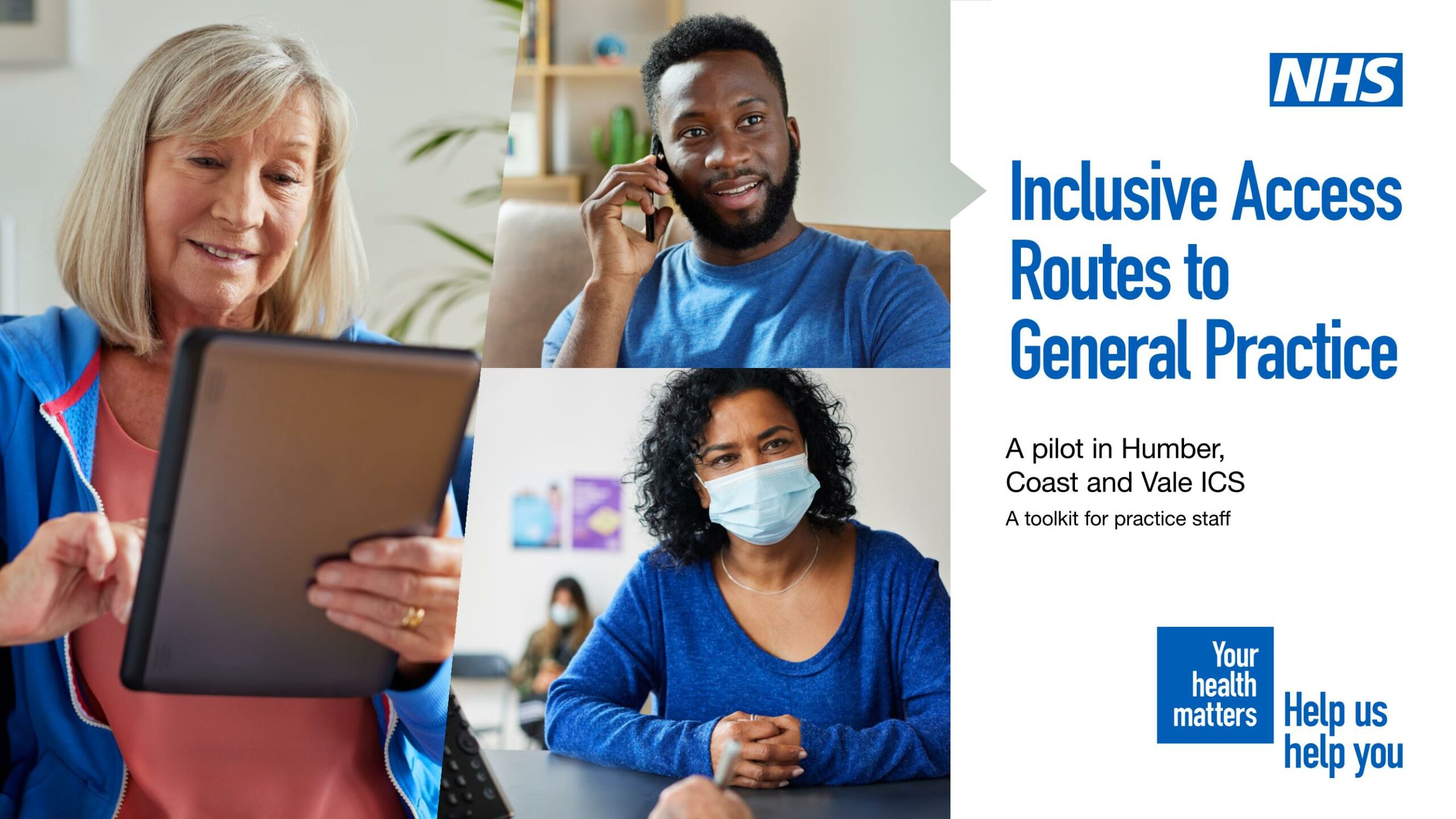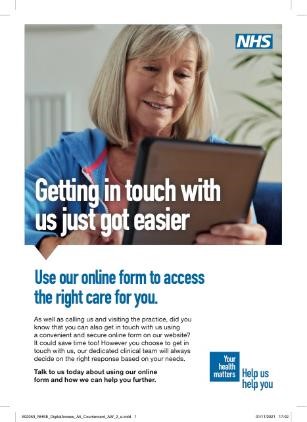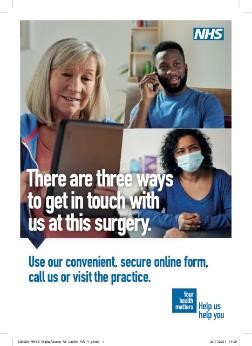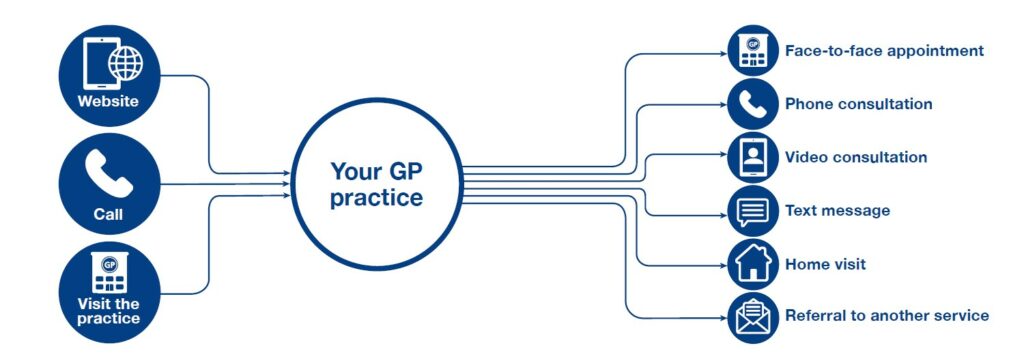Introduction
- This summary evaluation of the “Inclusive Access Routes to General Practice” pilot is for local, regional and national stakeholders across primary care, including General Practices, Primary Care Networks and Integrated Care Systems. It shares the key findings and learning from the pilot about the importance of having well-targeted, consistent communications to enable patients to improve their awareness and understanding of the many recent changes in access to general practice care and to build their confidence in these.
- Specifically, it shares insights from patients, GPs and staff of the 69 general practices who took part in the pilot, about the effectiveness of carefully tested messages in a range of printed and digital communications materials designed to help practice staff – GPs, nurses and administrative teams – to explain to patients how to use online consultation requests and the benefits of doing so.
- In short, that there are three ways patients can request care from their GP practice – by phone, in person and using a secure online form on their practice’s website. Whatever route they choose, patients will get the care they need – whether through a face-to-face appointment, a phone or video call, a text or online message, a home visit or a referral to another service.
About this evaluation report
- This summary report of the evaluation of the “Inclusive Access Routes to General Practice” pilot is available on the NHS England website at: https://www.england.nhs.uk/gp/
- A full evaluation report (circa 100 pages), carried out by Solutions Research, an independent research specialist, is available on FutureNHS (login required) at: https://future.nhs.uk/connect.ti/DigitalPC/grouphome or on request by email to england.digitalfirstprimarycare@nhs.net
- NHS England would like to thank the Humber and North Yorkshire ICS pilot steering group (previously known as the Humber, Coast and Vale ICS pilot steering group) for its support throughout the pilot and to the staff and patients of the 69 general practices who took part for their valuable contributions and insight.
Contact us
- The materials used in the pilot were made available nationally in December 2021 for all healthcare partners and general practices to download via the Campaign Resource Centre. They can be viewed here (login required): https://campaignresources.phe.gov.uk/resources/campaigns/70-general-practice-access-routes/resources
- Please get in touch with us if you would like to discuss this summary report further. Send an email to: england.digitalfirstprimarycare@nhs.net
Background to the pilot
- From March 2020 there were rapid changes to how patients could request care from their general practice as a result of the Coronavirus pandemic.
- Healthwatch England and National Voices identified a range of challenges for patients who were seeking to understand these changes and gain access to general practice care.* (GP access during COVID-19, Healthwatch England, March 2021; **The Dr will Zoom You Now, National Voices, July 2020).
- The “Inclusive Access Routes to General Practice” pilot was developed to help general practices to address some of the communications challenges identified – specifically, a lack of understanding and awareness of online consultation requests and a lack of confidence in how these would be responded to by practices.
Purpose of the pilot
- The purpose of the pilot was to work with practices, healthcare partners and patients to develop and test materials designed to increase awareness and understanding of the changes in general practice and to make access request routes more inclusive.
About the pilot
- The pilot took place in the Humber and North Yorkshire Integrated Care System (ICS) area. Planning began in April 2021. The ICS led a pilot steering group of local, regional, and national partners. A toolkit of communications materials was developed based on research with patients, practice staff and following consultation with Healthwatch England, Healthwatch Hull, and National Voices. The resulting toolkit of print and digital materials was shared with participating practices in November 2021 for them to use as they saw fit. The pilot ended in April 2022.
- Sixty-nine practices of varying sizes took part. They serve communities in towns, cities and rural districts from six clinical commissioning group areas. Some practices were experienced users of online consultation systems, others less so. They used four different online consultation systems and had varying rates of usage of online requests by their patients, both below and above the national average. The average deprivation decile of their patient populations (based on the Index of Multiple Deprivation 2019), ranged from 1 to 10. Thirty one pilot practices were in the City of Hull, one of the most deprived areas in England* (PHE Health Profiles, 2019).
- A pilot timeline is shown at Appendix A.
The pilot’s three aims
- Support pilot practices to raise awareness and understanding of the three ways patients can request care from their GP, particularly via online consultation requests.
- Encourage patients, including vulnerable and marginalised patients, to be confident to choose online consultation requests where appropriate.
- Obtain learning for the development of national materials that support inclusive access for all patients.
The pilot toolkit and materials
- Each participating practice received a “toolkit” of printed and digital materials to use as they deemed appropriate to support communications with staff and patients about the access route changes.
- The toolkit included guidance for general practice staff on how to use the materials and a range of digital and printed assets.
- The main focus of the materials was to explain the “three ways to get in touch with your general practice” – i.e. by telephone, by visiting the practice in person or by using an online form on the practice’s website.
- Development of the materials, including the language used and the creative approach, used insight from pre-pilot qualitative research among patients, practices, national, regional and local stakeholders.
- A list of the toolkit’s contents sample materials are shown at Appendix B.
Did the pilot work?
- Evaluation of the pilot was undertaken from April to May 2022 using questionnaires and in-depth interviews with 123 patients and 53 GPs and practice staff in the Humber and North Yorkshire ICS area. Appendix C provides an overview of the methodology.
Key research findings were:
- Smaller practices benefitted most from the toolkit.
- Practice managers welcomed the support of practical resources that they could quickly implement.
- Before exposure to pilot materials, 14% of patients were aware of ‘using a secure online form’. 53% were open to trying online consultation (OC) requests ‘if it gets me what I need’.
- After exposure to the materials, 64% patients reported they left them feeling confident their practice would respond in appropriate way.
- 22% said the materials had ‘given me confidence in trying new ways of contacting my GP practice’.
- Practices need further, continued support to make best use of toolkit materials and to enable them to build patient awareness and understanding of the new ways of asking for and receiving care from their GP practice – this awareness-building needs to last for months and years.
What worked well?
- The pilot toolkit was considered particularly helpful by practices in the early stages of their digital journey – either practices that had ‘not started’ or those ‘getting going’ with communicating about online consultation requests to patients.
- Some practices reported positive indications that the toolkit helped raise patient awareness and positivity towards online consultation requests – notably a reduction in complaints about access during the pilot. Explaining the range of responses by clinicians to online requests built patient confidence.
- The creative approach had many strengths: visually inclusive, clear and had a simple to understand message.
- Among staff and patients, word of mouth was particularly effective at driving awareness and encouraging trial of new access routes. When done systematically it was felt to have greatest impact on patient uptake of online consultation requests.
- Practices were happy to take responsibility for communications and saw themselves as having a pivotal role in communicating directly with patients about access routes.
What didn’t work well?
- There were substantial practical challenges to the impact of the pilot, including staff shortages and increased workload with Covid-19. However, other challenges included staff perceptions of online consultation requests: some practices felt that they had already communicated sufficiently about access routes to patients and didn’t need to do more. Some wanted more support to help engagement with particular local communities.
- In some practices there was uncertainty about their ability to cope with further online consultation requests – this acted as a barrier to promoting them to patients.
- There can be sensitivity to messaging about GP access as some patients perceive communications about access routes to be pushing them in a particular direction – for example, away from face-to-face care – to benefit the practice rather than them.
- Evidence that practice engagement with toolkit guidance was relatively low – some potentially useful elements of guidance were missed. This points to the need for increased support.
- Some practices were keen to individualise the printed materials, linking the message and their website / phone number / address. It was also felt that having both NHS branding and information more obviously from the GP practice might increase trust in the initiative. However, notwithstanding this, editable online versions provided to practices were largely unused.
Key learning: communicating to patients
- Address default of telephone
- Accessing the GP practice by telephone was identified by staff and patients as a habit.
- This is a significant and persistent barrier to patients changing their behaviour that requires specific initiatives to address, including, but not exclusively, communications.
- Calls for national campaign
- GP practice staff suggested there would be value in a national campaign around changes to GP access, to support practice-led messaging. Many also felt broader communications were needed to engage patients with understanding the changes to primary care models.
- Need for consistent language
- There was inconsistency in language used by both staff and patients when talking about online consultation requests and access generally. There is a need for consistency nationally and locally and a shared understanding of could be done to help build awareness and confidence. Some additional learning around key information needs of patients is shown at Appendix D.
- Healthy appetite to use online consultation requests
- 53% of patients who were surveyed agreed or strongly agreed, indicating ‘I am open to trying a secure online form if it gets me what I need’ – yet only 14% were aware of online consultation requests when given a list of access routes. This showed a need to build awareness. However, to build confidence there is a need to demonstrate and explain the benefits of online consultation requests.
Key learning: supporting practice confidence
- Build whole team confidence in online consultation systems
- When the whole practice team is on board with using online consultation systems it changes the conversation and makes it easier to promote online consultation requests to patients, particularly by word of mouth.
- Support practice managers to build staff buy-in
- Practice managers have a key role in encouraging and firming up buy-in of administrative and clinical staff and of ensuring all staff are communicating with patients the same way.
- Provide check-ins or similar to link practices up
- Team up practices to promote unity of mission and consider check-ins and mentoring support with practices with higher online consultation request rates to help rapid spread of systems and processes.
- Identify and share effective operational models
- The research suggested that differences in the operational model used could influence staff attitudes to the system. Online consultation systems were sometimes switched off when there was high demand or staffing problems. Some practices felt that online consultation systems created extra work.
Appendix A: Plot timeline
- April to August 2021 – Scoping. Steering group set up. External agencies commissioned.
- September to October 2021 – Qualitative research among patients, practices, and local stakeholders to inform campaign language and creative.
- 22 November 2021 – First draft toolkit shared. Briefing webinar.
- 29 November 2021 – Pilot launched.
- December 2021 – Omicron, Coronavirus variant of concern, wave.
- Early December 2021 onwards – National booster vaccination campaign.
- 12 December 2021 – 1 February 2022 – Pilot paused.
- 2 February 2022 – Pilot resumes.
- 30 April 2022 – Pilot ends.
- 1 May – 7 June 2022 – Evaluation activity: Feedback surveys and interviews with patients and ‘focus’ practice staff.
Appendix B: Toolkit materials and GP Practice access model
Printable / printed materials in the toolkit included:
- Standard poster in A4 and A3 format
- Blank and editable PDF poster
- Leaflet
- Draft letter to patients
- Counter-card for reception desks
Digital materials included:
- Digital screen (animated and static assets)
- Social assets (static posts)
- Online contact slips
- Voice message and text message script
- Magazine copy
- Website template copy
- Additional formats (Easy Read, Braille and translations)
Examples of the materials used in the pilot are shown below:




Appendix C: Evaluation – methodology overview
| Method | Audience | Timing | Intended number of responses | Achieved number of responses |
| Online survey | GP practice staff in pilot area | Fieldwork after pilot end | At least one person in each of 69 GP practices | 36 completed surveys |
| Depth interviews | GP practice staff in 10 ‘focus’ practices | Fieldwork after pilot end | 4 staff members per practice (40 total) | 17 interviews (8 practices) |
| Online survey | Patients* of 10 ‘focus’ practices | Fieldwork during pilot and after pilot end | Paper-based – minimum of 10 per practice Online – minimum of 10 per practice | 111 completed surveys – 73 online and 38 paper |
| Depth interviews | Patients* of 10 ‘focus’ practices | Fieldwork after pilot end | 4 patients per practice (40 total) | 12 interviews |
*aged 17 or over, who contacted the surgery for any reason and by any contact route, and/or who attended the surgery on the day
Appendix D: Key patient information needs
The pilot identified the following information needs for patients:
- To drive greater confidence in the use of online consultation requests among patients there is a need to promote, demonstrate and explain their benefits to patients.
- In particular, practices feel that explaining how online consultation requests work and how they respond by ensuring all patients get the care they need (i.e. the same as a telephone or in person request) is critical to building patients’ confidence.
- The most interested patients call for ‘how-to’ guides on using the system to build understanding of what is involved, how it works, and further explanation of benefits to them of using this new access route.
The key patient information needs are therefore:
- Why the NHS is adding online consultation requests into primary care.
- What the digital system is (or indeed systems are).
- Which circumstances to use different access routes.
- What is available at their GP practice and where to find it.
- Roles and job titles of all general practice staff should be explained and made accessible to patients on individual practice websites, for example, what an associate nurse practitioner is.

